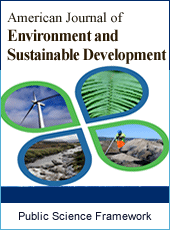American Journal of Environment and Sustainable Development
Articles Information
American Journal of Environment and Sustainable Development, Vol.3, No.1, Mar. 2018, Pub. Date: May 28, 2018
Problems of Date Palm Production in Nigeria
Pages: 6-12 Views: 2168 Downloads: 5230
[01]
Sanusi Mohammed Kabiru, Nigerian Institute for Oil palm Research (NIFOR) Date Palm Sub-station, Dutse, Jigawa State, Nigeria.
[02]
Adeloye Florence Fadeke, Department of Agricultural Extension and Rural Development, Faculty of Agriculture, University of Ibadan, Ibadan, Nigeria.
Nigeria has vast land mass and suitable climatic condition to produce date palm in large quantities. However, date palm production in Nigeria is low and it becomes difficult for the industry to perform its statutory role to promote economic development. The study identified the problems confronting the Date Palm industry and proffer solutions to them. The problems identified by the study include lack of government assistance in term of loans, inputs, low budgetary allocation and lack of land to cultivate Date palm. Others were pest and diseases, poor extension services, lack of planting materials, sex identification and lack of knowledge on the numerous uses of date palm. The study recommended that government should assistant the farmers to get loans to buy input like fertilizers, insecticides and pesticides. Government should acquire large hectares of land that will be designated for date palm production as well as increase budgetary allocation for date palm research. Extension system should provide information on the importance and uses of date palms to the farmers. Date palm farmers should form functional date palm cooperatives society to get assistance from government and commercial banks.
Date Palm, Production, Problems, Solutions, Economic Development
[01]
Adesiji, G. B., Olujide, M. G., Bolarin, O., Sanusi, M. K. and Komolafe, S. E. (2013). An assessment of date palm technologies utilized by the farmers in Dutse Local Government Area of Jigawa State, Nigeria. Journal of Sustainable Development in Africa. Volume 15, No. 8. Pp., 11-20.
[02]
Allou, K., Morin, J. P., Kouassi, P., Hala, N. and Rochat, D. (2006) “Oryctes monoceros. Trapping with synthetic pheromone and palm materiel in Ivory Coast”. Journal of Chemical Ecology, Vol. 32, 1743-1752.
[03]
Botes A. and Zaid A. (Ed.). (2002). The economic importance of date production and international trade. Date palm cultivation. FAO plant production and protection. Rome. Paper 156 Revision 1.
[04]
Dada, M., Nwawe C. N., Okere, R. A. and Uwubanmwen, I. O. (2012). Potentials of Date palm tree to the Nigerian economy. World Journal of Agricultural Sciences, 8 (3), Pp.:309-315.
[05]
FAO (2006): Date palm product. www.fao.org/dorep/t0681E/t08/E00.htm. Chapters 1-5
[06]
Glasner, B., A. Botes, A. Zaid (Ed.) and J. Emmens. (2002). Date harvesting, packing house management and marketing aspects. Date palm cultivation. FAO plant production and protection. Rome. Paper 156 Revision 1.
[07]
NIFOR In-house review article, 2005.
[08]
Popenoe, W. (1913): Date growing in the Old and New Worlds. West India Gardens. Altadena, California, pp. 316. Cited in Zaid A. (Ed.) and De Wet P. F. (2002). Origin, geographical distribution and nutritional values of date palm. Chapter ii. Date palm cultivation. FAO plant production and protection. Rome. Paper 156 Revision 1.
[09]
Popenoe, P. B. (1973): The date palm. Henry Field, ed., Field Research Projects, Coconut, Miami, Florida. pp. 247. Cited in Zaid A. (Ed.) and De Wet P. F. (2002). Origin, geographical distribution and nutritional values of date palm. Chapter ii. Date palm cultivation. FAO plant production and protection. Rome. Paper 156 Revision 1.
[10]
Sanusi, M. K, Omokhudu, C. A. and Adeloye, F. F (2017). Date Palm Farmers' Sources of Information in Dutse Local Government Area of Jigawa State, Nigeria, Journal of Agricultural & Food Information. https://doi.org/10.1080/10496505.2017.1382363
[11]
Sanusi M. K, Omokhudu, C. A., Bello, O. G., and Yahaya S. A. (2016). An Assessment of Knowledge Level of Date Palm (Phoenix dactylifera L) Farmers in Dutse Local Government Area of Jigawa State, Nigeria. World Journal of Agricultural Research, vol. 4, no. 2: Pp. 36-42.
[12]
Sanusi M. K, Omokhudu C. A and Yahaya S. A. (2014) control of oryctes monocros on date palm field in Sudan-savannah vegetative zone of Nigeria. World journal of Agricultural Research. Vol. 2, no. 6, Pp. 285-290.
[13]
Sanusi M. K. (2012). Assessment of date palm technologies utilized by the farmers in dutse local government area of jigawa state. Msc. thesis in the Department of Agricultural Extension and rural development, University of Ibadan, Ibadan, Nigeria. Pp. 1-30.
[14]
Soyebo, K. O., Farinde, A. J. and Dionco-Adetayo, E. D. (2005). Constraints of Oil Palm Production in Ife Central Local Government Area of Osun State, Nigeria. Journal of Social Science. Volume 10 No.1: Pp.: 57.
[15]
Zaid A. (Ed.) and De Wet P. F. (2002). Botanical and systemic description of the date palm. Chapter i. Date palm cultivation. FAO plant production and protection. Rome. Paper 156 Revision 1.
[16]
Zaid A. (Ed.) and De Wet P. F. (2002). Origin, geographical distribution and nutritional values of date palm. Chapter ii. Date palm cultivation. FAO plant production and protection. Rome. Paper 156 Revision 1.
[17]
Zaid A. (Ed.) and De Wet P. F. (2002). Date palm propagation. Chapter v. Date palm cultivation. FAO plant production and protection. Rome. Paper 156 Revision 1.
[18]
Zaid. A. (Ed.), De Wet, P. F., Djerbi M. and Oihabi, A. (2002). Diseases and pest of Date palm. Date palm cultivation. FAO plant production and protection. Rome. Paper 156 Revision 1.
[19]
Wisegeek, 2011. http://www.wisegeek.com/what-is-a-date-palm.htm

ISSN Print: Pending
ISSN Online: Pending
Current Issue:
Vol. 6, Issue 4, December Submit a Manuscript Join Editorial Board Join Reviewer Team
ISSN Online: Pending
Current Issue:
Vol. 6, Issue 4, December Submit a Manuscript Join Editorial Board Join Reviewer Team
| About This Journal |
| All Issues |
| Open Access |
| Indexing |
| Payment Information |
| Author Guidelines |
| Review Process |
| Publication Ethics |
| Editorial Board |
| Peer Reviewers |


